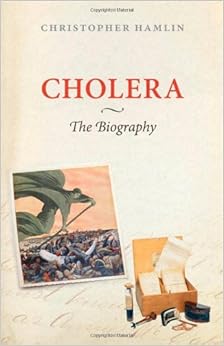This book is an attempt on the part of
the author to create a comprehensive history of cholera from the
first recognized outbreaks of 1817 to the modern day where it
continues to linger in less industrialized countries. I want to say
that this book is an attempt at a deconstruction because it veers
away from the standard cholera narrative which idolizes John Snow and
his research around the Broad Street Pump. Hamlin by contrast depicts
Snow’s efforts as one of many competing attempts to define what
exactly the cause of cholera was, as well as part of a larger
movement for clean water. Hamlin also mentions Robert Koch, the
Prussian scientist credited with identifying the bacteria that causes
cholera, however Koch’s work seems undermined in this particular
text because of more recent research that shows Vibro cholerae,
the bacteria generally credited with causing cholera, is more
susceptible to mutation than originally thought. However, Hamlin’s
conclusions seem almost to be that nothing can truly be understood
which seems fatalistic at best.
In his chronicle of cholera research,
Hamlin depicts a stumbling, staggering process in which science
advances in fits and starts with only gradual progress. The result is
a rather confused narrative that seems to jump about from topic to
topic in a mostly disorganized manner. It may be that because I read
this book a bit at a time I was left rather confused because I kept
picking it up and putting it down, but the overall disorganization of
his text seemed rather consistent through the book. I seriously doubt
that was a stylistic choice as this is an academic text, and reflects
rather poorly on the author in my opinion. Hamlin does follow the
attempts to define cholera, beginning in the early nineteenth century
where cholera goes from a seasonal, non-contagious, and largely
survivable affliction of diarrhea to a highly contagious and largely
fatal disease; at least according to contemporary reports. Hamlin
does call into question the fatality of cholera considering several
reports were highly inflated and the number of dead rounded to the
nearest thousand. However there are also confirmed reports with at
least a fifty percent mortality. It seems like Hamlin is trying to
have it both ways in his argument, which brings the whole thesis into
question.
As I said, Hamlin depicts the
scientific research into cholera as a stumbling process where
scientists aren’t always sure what they’re looking for, which you
get the impression he sees as a defect. Yet that’s the whole
benefit of the scientific method. We’re never entirely sure about
anything. Scientists can create entire theories around existing
evidence and experimentation which may answer our questions about
life, the universe, and everything, but science also takes into
consideration that new evidence may turn up which will totally
redefine our understanding of the universe. The very nature of a
scientist is to be unsure about anything and ultimately we’re
hazarding a best guess. Of course, this best guess may be backed up
by boatloads of evidence, but there can always be more evidence to
consider. It seems like Hamlin is accusing science of being flawed
because it’s not one hundred percent certain about everything all
the time and often gets things wrong.
From a more cultural perspective, this
book also seems to be significantly lacking. Hamlin makes an effort
to explain the cultural significance of cholera as well and how it
became a major fear of popular consciousness. However, very little of
the text seems dedicated to an analysis of the cultural aspect. There
is mention that it gets tied to sanitary reform movements (which
considering its vector of infection is certainly valid) as well as
the early attempts by governments to try and do something to
combat cholera, even if they weren’t sure what that something would
be. There was also a struggle among nations to prevent the spread of
cholera through quarantines, which received some resistance due to
their hampering of trade. However any cultural analysis takes a
definite backseat to the scientific analysis. In the end, cholera
becomes a social stigmata, implying uncleanliness and a primitive
inability to maintain basic hygiene, resulting in a hesitation to
even announce an outbreak of cholera. However, as the industrializing
world still faces challenges in providing clean water supplies,
cholera remains a problem today.
Overall this book is just a mess. I did
learn some new things about cholera from it, but the book is highly
disorganized and provides a very muddled narrative with very little
structure. Hamlin’s almost yet not quite critique of science and
its inability to provide the correct answers right away seems petty
and ignorant, especially coming from a researcher. I don’t think
I’d recommend this book just because it’s such a jumbled mess.
- Kalpar


No comments:
Post a Comment